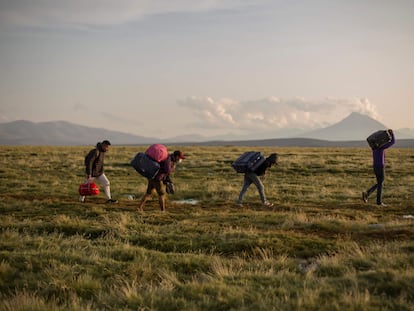Photo essay: Bolivia’s Mennonite community
The fires that ravaged Bolivia’s Santa Cruz province drew the attention of Italian photographer Fabiomassimo Antenozio. There, he discovered the Mennonites, who have been established in the area since the mid-20th century. Three years later he returned to deepen his knowledge of their reality, which is shaped by the land, the Bible and pesticides

In 2020, the fires in Bolivia — which are suspected of having been set to expand the agricultural frontier into forested areas — prompted me to go on a trip to Chiquitania, the most affected region and the last tropical dry forest in Latin America. This first three-month-long experience of touring these places allowed me to have contact with the Mennonite community, which has been settled in the area since the 1950s. Mennonites are an Anabaptist society centered on agriculture. Here, they are dedicated to the extensive production of soybeans and transgenic corn and raising cattle. They reject modernity, violence and laziness. Conservative and traditionalist, they speak Plautdietsch (also known as Mennonite Low German); only a few can speak proper Spanish. Women face particularly difficult conditions, as they are always forced into subordinate roles.
Back in Italy, I realized that some pieces to complete my report were still missing. So, I returned to Bolivia in January 2023. I travel aboard a 1993 Hyundai Galloper through cities, markets, communities, soybean and corn fields, extensive cattle breeding, forests and desolate lands. I immerse myself in tropical nature, in the light of the 10-minute period before sunset, in the aroma of plants, fruits, rain, 1980s car diesel, sweat and pesticides. In the sounds of nocturnal animals, of mechanical devices, of restless horns, of biblical chants in an unknown language. In screams drowned out by the fear of God.

From the Santa Cruz market, where stalls sell pesticides and farm products among signs and writings in Plautdietsch and references to sacred texts, I set out for the countryside to reconnect with this Anabaptist community. Upon my arrival, I discover that one of them, Isaac Peter, whom I met in 2020, has undergone surgery for a melanoma in his mouth. Three years later, the tumor has reappeared and spread, paralyzing the left side of his body. I find him lying in bed; his voice weak. He is surrounded by his wife, his daughter and some neighbors; they explain to me that he did not want to return to Brazil, where medical care is free, even for adults. He did not want to leave the countryside or his family.
I continue my journey to the Oncology Hospital in Santa Cruz, where I meet two people who will have a profound impact on me: Eva, a seven-year-old Mennonite girl with ovarian cancer, and her mother, Catarina, who weeks later falls ill and then dies less than two hours later, supposedly a victim of dengue fever.

I left without knowing if there is a direct relationship between the pesticides used on crops and the cancer rate in the Mennonite community.
I continued on my way to the town of Concepción. I wanted to meet the other Mennonites I met on my first visit. They live in the one community that only uses horses as motive power. The settlement has a unique charm and the people who live there are different from other Mennonites, purer, less interested in material possessions and more focused on spirituality. Here, trees of Amazonian origin coexist with palm trees and cacti.
I leave the colony; an image follows me. A school located in a church, where I meet boys dressed in overalls and shirts, girls in blue or green dresses and a black headscarf. They all go barefoot because, in their culture, it is important to be in contact with the earth. Two teachers are with them: a man who reads aloud from the Bible, the only text from which they study and learn; near the front door, his wife is teaching some girls addition and subtraction. Here only reading, writing and counting are taught. There’s no drawing, no coloring, no painting. They don’t know what that is.

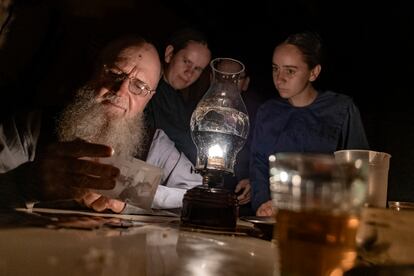

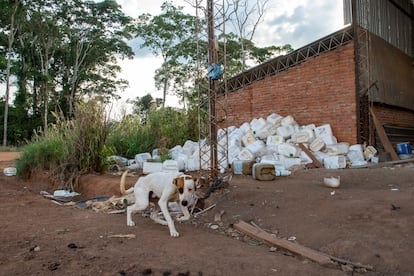
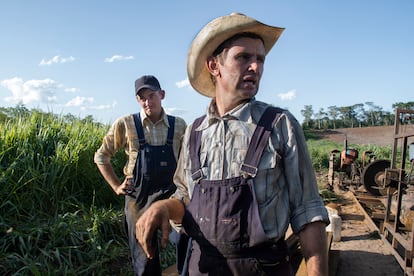
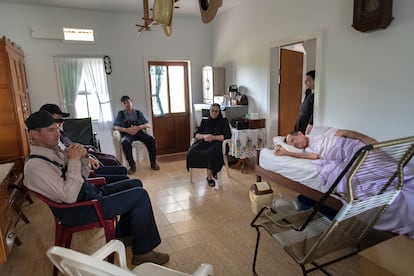
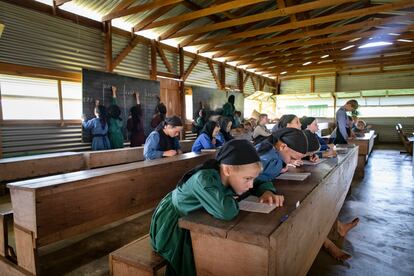
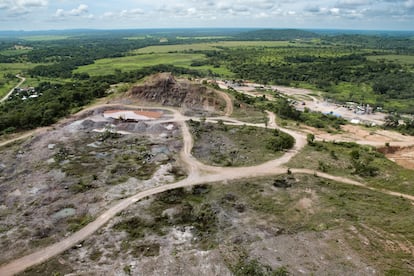
Sign up for our weekly newsletter to get more English-language news coverage from EL PAÍS USA Edition
Tu suscripción se está usando en otro dispositivo
¿Quieres añadir otro usuario a tu suscripción?
Si continúas leyendo en este dispositivo, no se podrá leer en el otro.
FlechaTu suscripción se está usando en otro dispositivo y solo puedes acceder a EL PAÍS desde un dispositivo a la vez.
Si quieres compartir tu cuenta, cambia tu suscripción a la modalidad Premium, así podrás añadir otro usuario. Cada uno accederá con su propia cuenta de email, lo que os permitirá personalizar vuestra experiencia en EL PAÍS.
¿Tienes una suscripción de empresa? Accede aquí para contratar más cuentas.
En el caso de no saber quién está usando tu cuenta, te recomendamos cambiar tu contraseña aquí.
Si decides continuar compartiendo tu cuenta, este mensaje se mostrará en tu dispositivo y en el de la otra persona que está usando tu cuenta de forma indefinida, afectando a tu experiencia de lectura. Puedes consultar aquí los términos y condiciones de la suscripción digital.
More information
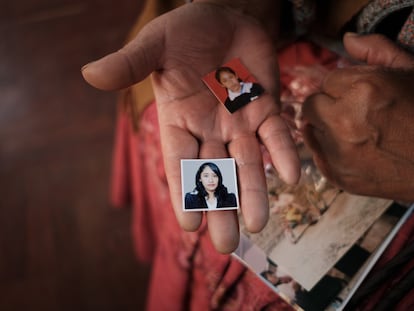
The abyss of child sexual exploitation in Bolivia: ‘They told me that if I continued looking for my daughter, I was going to die’
Archived In
Últimas noticias
Trump claims peace in Ukraine is near, but Moscow suggests otherwise
A survivor’s account of the Interoceanic Train accident: ‘We were scared because of the speed on the curve’
The Interoceanic Train, the Mexican alternative to the Panama Canal
What is known about the Interoceanic Train derailment in Oaxaca
Most viewed
- Oona Chaplin: ‘I told James Cameron that I was living in a treehouse and starting a permaculture project with a friend’
- Reinhard Genzel, Nobel laureate in physics: ‘One-minute videos will never give you the truth’
- Why the price of coffee has skyrocketed: from Brazilian plantations to specialty coffee houses
- Pablo Escobar’s hippos: A serious environmental problem, 40 years on
- Chevy Chase, the beloved comedian who was a monster off camera: ‘Not everyone hated him, just the people who’ve worked with him’
